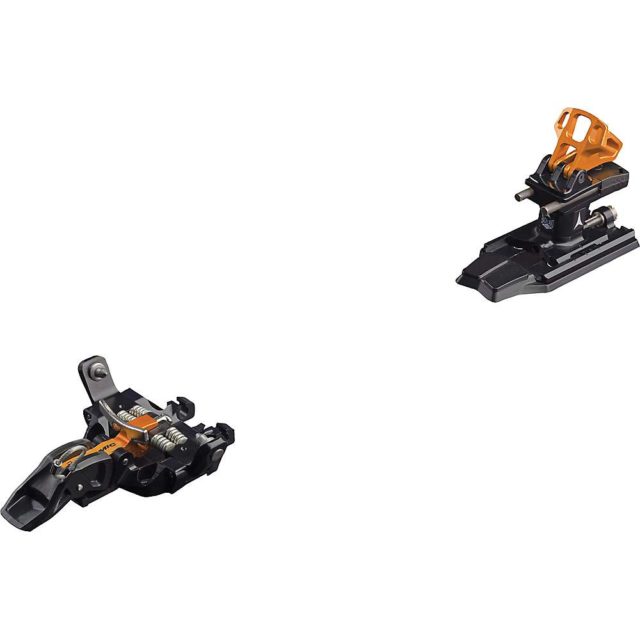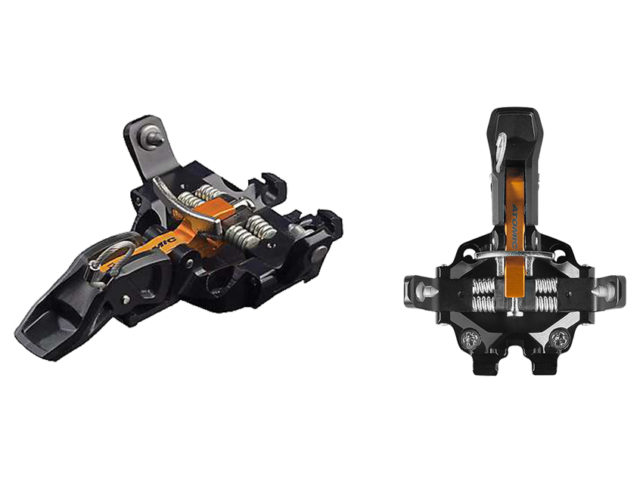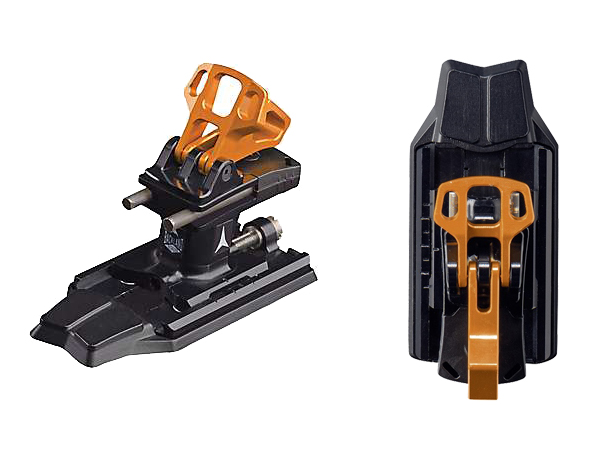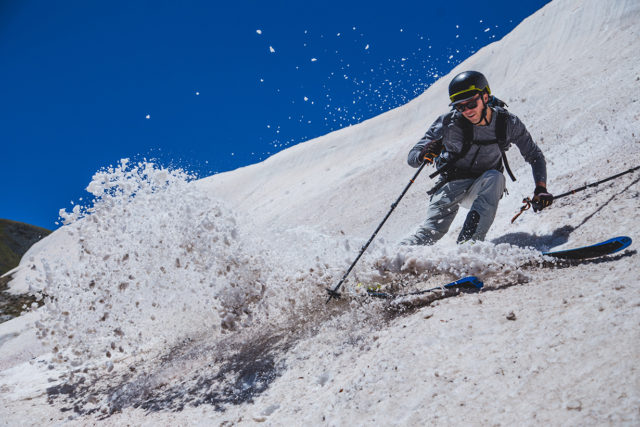
2020-2021 Salomon MTN Pure / Atomic Backland Pure
Release value range: “women”, “men”, & “expert” (adjusted by changing out U-spring in heel)
Available brake widths: 80, 90, 100, 110, 120 mm
Climbing Aids: flat, 42 mm, 58 mm
Forward Elastic Travel: 0 mm
Mounting pattern width: 40 mm (toe); 28 mm (heel)
Heel Mounting Gap: 4 mm
BSL Adjustment: 30 mm
Stated Weight: 296 grams
Blister’s measured weight:
- Toe: 119.3 & 118.7 g
- Heel: 163.6 & 163.9 g
- Leashes: 25.8 & 25.6 g
- Screws: 15.3 & 15.5, g
- Total (with leashes): 324.5 & 323.2 g
MSRP: $449 USD ($499 for version with brakes)
Boots Used: Scarpa Maestrale RS; Nordica Strider 120; Tecnica Zero G Tour Pro; Atomic Backland Carbon
Ski Used: Salomon MTN Explore 95
Test Locations: Arapahoe Basin & Front Range Backcountry, CO; Teton Backcountry, ID
Days Tested: 8
[Note: Our review was conducted on the 19/20 MTN / Backland Tour, which was not changed for 20/21, apart from the name changes to “Salomon MTN Pure” and “Atomic Backland Pure.”]
Intro
Salomon and Atomic got a lot of attention this past season when they announced their Shift MNC binding, and deservedly so — the Shift is a big step forward for downhill-oriented touring bindings that deliver the skiing performance of an alpine binding.
But Salomon and Atomic also make a touring binding that sits on the opposite end of the spectrum, where simplicity, low weight, and uphill performance are the priorities. The Salomon MTN / Atomic Backland Tour takes the classic, minimalist, tech-binding design and includes a few notable upgrades, making it an interesting addition to the lightweight touring binding category.
(Both companies sell their own version of this binding, but apart from the names and colorways, the two bindings are identical.)
And for the record, this is a great example of how good backcountry skiers have it these days.
Just a few years ago you’d either be stuck hauling up a heavy and inefficient frame binding, or ski on super minimal (and often unreliable) tech bindings. But now we’re seeing a lot of innovation on both ends of the touring market, and there are now more options than ever in the lightweight tech-binding category — several of which we’ve covered in our Lightweight Touring Binding Shootout.
So how does the MTN / Backland Tour compare?
We’ve now had several reviewers use the MTN / Backland Tour. We’ve skied it back-to-back against the other bindings in our shootout at A-Basin, and toured on it around the mountains of the American West. Here’s what we’ve found:
Design
Toe Piece
Luke Koppa: The MTN / Backland Tour’s toe piece is very simple and reminiscent of many traditional tech binding designs. It’s made primarily of metal, with the upper toe lever being the only plastic piece. We haven’t yet spent enough time in the MTN / Backland Tour to test its long-term durability, but its construction (both in the toe and heel) feels very solid and the binding has fewer parts (that could potentially break) than all of the other bindings in our shootout.
The MTN / Backland Tour features a small, metal bar at the the front of the toe piece to help guide the foot when stepping in. While this makes the MTN / Backland Tour easier to step into than the Marker Alpinist, it’s not the easiest binding in our test when it comes to stepping in (more on that further down).

The MTN / Backland Tour’s toe piece has the widest mounting pattern of all the bindings in our shootout. While it’s difficult to determine exactly how much this affects power transfer or binding retention, the wider mounting pattern does inspire a bit more confidence (warranted or not) when driving wider skis.
While the MTN / Backland Tour’s toe piece has a lower pivot point than the Marker Alpinist, the MTN / Backland Tour’s toe piece feels like it requires more force to close and open it compared to the Dynafit TLT Speed and Alpinist. We haven’t used lab equipment to objectively test which bindings have the strongest holding power in the toe, but the MTN / Backland Tour definitely feels quite strong when opening and closing the binding.
Heel Piece
Luke: The MTN / Backland Tour’s heel piece combines classic tech binding design with a couple small, but noteworthy upgrades. Like the toe piece, the MTN / Backland Tour’s heel piece is mostly made of metal, with the exterior U-spring housing being the only plastic piece on the heel.
The MTN / Backland Tour’s heel piece utilizes a U-spring that determines both lateral and vertical release. The binding includes three spring options of increasing retention values, labeled as “women,” “men,” and “expert.” We tested the binding with the medium-strength, “men” spring. [Editor’s Note: we’d love to see a more useful labelling system for retention values. What’s wrong with numbers, or just something like “low, medium, high?”]

Like all the bindings in our shootout, the MTN / Backland Tour’s heel rotates to transition from ski to walk mode. However, unlike all the other bindings, there’s no need to rotate the MTN / Backland Tour’s heel a full 180° because its heel risers move independently from the actual heel tower. This means that you only have to rotate the MTN / Backland Tour’s heel about 90° to get a flat mode. Or if you just want to go straight to the low or high riser setting, you can flip the risers over the pins with the heel piece in downhill mode, making for quicker transitions when you don’t need to use the flat mode.
The independent risers are one of our favorite features on the MTN / Backland Tour, though they do come with a few quirks which we discuss in the Uphill Performance section further down.
In addition to the MTN / Backland Tour’s heel risers, it also stands out due to its mounting plate, which comes standard with 30 mm of adjustment (the ATK Raider 2.0 12 / Hagan Core 12 also has 30 mm of adjustment). This is a nice feature for people with multiple pairs of boots with different BSL’s, or on the occasion that you lend your skis to a buddy.
Leashes
Luke: The MTN / Backland Tour is available either with brakes or leashes. We tested the binding with the included leashes, which I think are really nice.
The leashes are pre-coiled, so when they’re not clipped to my boots (e.g., on a bootpack), they stay shorter / compressed and keep from swinging around and whacking me in the face. The MTN / Backland Tour’s leash clip is also exactly 4 mm thick, which means you can use it to correctly measure the heel gap between the MTN / Backland Tour’s heel piece and your boot. Nice.
Brakes
The MTN / Backland Tour can be purchased with brakes instead of leashes, and the brakes can also be purchased separately. The MTN / Backland Tour’s brakes have a stated weight of 96 grams per brake, and work independently of the heel tower. They instead utilize a lever that flips forward or backward to release / lock the breaks (similar to the brake on the Salomon / Atomic Shift binding). With the brake attached, the “flat” mode of the MTN / Backland Tour is slightly … less flat (as the brake takes up some space under the boot sole at the heel). Though since we haven’t used the brakes, we can’t attest to just how much of a difference this really makes on snow. We don’t expect the difference to be drastic.
Crampons
Neither Salomon or Atomic make ski crampons specifically designed for the MTN / Backland Tour, but the binding reportedly works with crampons from both Dynafit and Plum.
Uphill Performance / Transitions
Luke: Overall, I think the MTN / Backland Tour is an excellent binding on the skintrack. It’s simple, allows for easy and quick transitions, and has proven to be pretty easy to use.
The only minor complaint I have with the MTN / Backland Tour comes when it’s time to step into the binding. While it features a toe stop to help guide your foot, I still found that it was a bit more difficult to step into the MTN / Backland Tour compared to the ATK Raider 2.0 12 / Hagan Core 12 and Dynafit TLT Speed. The MTN / Backland Tour requires a bit of force in the forward direction (i.e., toward your ski tip) in addition to just simply pushing straight down in order to get the toe jaws to snap shut. I still found the MTN / Backland Tour to be easier to step into than the Alpinist, and think I could easily get used to the MTN / Backland Tour after spending more time on it.
Once clicked in, the MTN / Backland Tour is a joy to tour on.
The MTN / Backland Tour’s heel risers are very easy to flick over with a ski pole basket or grip, and I really like the fact that they work independently of the heel tower. The MTN / Backland Tour’s high riser is also actually that — high. I found that it was plenty tall for steep skintracks, and noticeably higher than the highest risers on the TLT Speed and Alpinist.
I like to minimize transition time whenever possible, mostly because I’m lazy, so it’s nice to have the option of simply flipping the low and / or high risers over the heel pins of the MTN / Backland Tour, touring up, and then flipping the risers back and clicking in my heel. This is especially useful on shorter laps where I’m transitioning many times throughout the day. The Raider 2.0 12 / Core 12 and Alpinist also function similarly in that you can just flip a riser over the pins when you don’t need a flat mode, though the Alpinist requires you to turn the heel piece 180° if you want access to its (fairly short) highest riser setting.
When I do want a flat mode, the MTN / Backland Tour’s heel is pretty easy to rotate, though since the risers don’t rotate with the heel tower I have to grip lower on the heel piece when rotating it. I found this annoying at first, but if I flipped the risers forward (so they were above the pins), it was much easier to rotate the heel tower since there’s a pretty large protrusion where the U-spring is, and that’s much easier to grab when the risers are flipped forward.
It’s also worth noting that, since the MTN / Backland Tour’s heel risers don’t rotate with the heel tower, it’s not possible to rotate the heel with a ski pole. But I found that the MTN / Backland Tour’s heel tower was easier and quicker to rotate by hand than those on the Alpinist and TLT Speed, in part due to the MTN / Backland Tour only requiring 90° of rotation.
Downhill Performance
We’re putting this same caveat in all of the downhill performance sections for the bindings in this test…
Two things really stood out to us while testing these bindings:
First, the downhill performance of each binding is surprisingly similar. If we weren’t skiing them back-to-back, we doubt we would be able to discern many differences in performance.
Second (and perhaps even more surprising), is how hard we were able to ski on these bindings without breaking anything — including ourselves.
Much of our downhill-performance testing was done inbounds on firm or soft, chopped-up snow and at very high speeds. All of the bindings in the test performed surprisingly well (though the real standout in our shootout was easily the ski — the Salomon MTN Explore 95 that we had all the bindings mounted on is just soooo good).
(End caveat.)
Luke (5’8”, 155 lbs): The MTN / Backland Tour feels the most traditional of all the bindings in our shootout. It has that distinctive tech binding “feel” that transmits a lot of feedback and sensation from the snow to my boots.
In our shootout, I think the MTN / Backland Tour feels the harshest, though I didn’t notice much of a difference between it and the Raider 2.0 12 / Core 12 in terms of the feedback transmitted to my boots. The TLT Speed felt slightly smoother than the MTN / Backland Tour, and the Alpinist was noticeably smoother than all the bindings in our shootout.

In terms of power transfer, I think the MTN / Backland Tour sits at the bottom of our shootout. Its heel felt more vague than the Alpinist and Raider 2.0 12 / Core 12, and pretty similar to the TLT Speed. That said, I was still impressed by how hard I could ski on the MTN / Backland Tour and MTN Explore 95 in the soft snow at A-Basin.
If I were solely choosing one of the four bindings in our shootout for its downhill performance, the MTN / Backland Tour would not be my top choice. But if you’re used to the feel of minimal tech bindings like the MTN / Backland Tour and correspondingly tend to ski a bit more conservatively while on lightweight gear, the MTN / Backland Tour skis pretty well for how light and simple it is.
Sam Shaheen (5’10”, 140 lbs): I agree with Luke on his assessment. The MTN / Backland Tour has the most traditional feel on snow. But I think it is important to reiterate that we skied these bindings back-to-back on the same ski, and even then, the differences between the bindings were very subtle.
I personally would happily use the MTN / Backland Tour as my primary lightweight touring binding. And honestly, I think that all of the bindings in this test would be fine options for general touring. So I would be careful about basing your decision primarily or strictly on the differences we’ve teased out in the downhill characteristics of these bindings. Other features (and perhaps the price differences) ought to be given more weight / are more important, I believe. So, yes, the MTN / Backland Tour feels the harshest of the bindings in our test, and yes, it has the worst power transfer. But the differences that we’re talking about here are quite subtle.
Safety / Release
Sam: U-spring bindings like the MTN / Backland Tour have been shown to prematurely wear out the pin inserts on touring boots and change the release characteristics over time (in some cases, release characteristics can change dramatically). This is in contrast to other (often heavier) tech bindings that have separate heel pins which move much more easily around the boot heel insert when stepping into the binding.
Every time you step into a U-spring binding, the spring itself needs to bend outward to get around the boot heel insert, which is more abrasive than bindings with independent heel pins (e.g., Dynafit Rotation 10, G3 Ion, Fritschi Vipec Evo).
For more on the potential safety issues with U-spring bindings, check out our podcast with some of G3’s engineers where they discuss this topic around the 41:00 mark.

U-spring bindings also have much less adjustability when it comes to vertical release, since the spring itself dictates the vertical release value. And in the case of the MTN / Backland Tour, its U-spring also determines its lateral release value.
When it comes to safety features, each binding in our shootout differs a bit:
- The Alpinist has adjustable lateral release and its vertical release is determined by the U-spring. However, it also has active length compensation to help with release consistency and is the only binding in our shootout that does not require a heel gap.
- The Raider 2.0 / Core has independently adjustable vertical and lateral release at the heel and features independent heel pins (i.e., not a U-spring). It also has active length compensation, but still requires a heel gap.
- The TLT Speed has fixed vertical release (U-spring-dependent), adjustable lateral release, and no active length compensation.
- The MTN / Backland Tour’s release values can only be adjusted by swapping the U-spring (there are 3 stiffness options), and the MTN / Backland Tour has no active length compensation.
It’s very difficult to determine how much each of these bindings’ features contribute to overall safety without a large-scale study. But if being able to really fine-tune the release characteristics of your binding is a priority for you, it’s important to note that the MTN / Backland Tour offers the least level of precise release adjustability of the bindings in our shootout.
Durability
Luke: After 8 total days of testing, we haven’t had any durability issues with the MTN / Backland Tour. But that’s hardly enough time to test a binding’s long-term durability, so we’ll be putting more time on the MTN / Backland Tour next season and will report back if any issues arise.
And I think it’s again worth noting that the MTN / Backland Tour is mostly composed of metal, with the U-spring cover and the upper toe lever being the only plastic components. The MTN / Backland Tour also has very few moving parts, and few parts in general. So I expect the MTN / Backland Tour to hold up well.
Who’s It For?
Luke: I think the MTN / Backland Tour is a good option for anyone looking for a simple, lightweight touring binding that’s easy to use, tours very well, and offers decent downhill performance. The MTN / Backland Tour isn’t the best choice if you prioritize precise release adjustability or want the best downhill-performing binding in this class. But if you’re not charging in your lightweight touring gear — i.e., you’re actually using it how it’s meant to be used — the MTN / Backland Tour is a strong overall performer.
Sam: I think the key with the MTN / Backland Tour is its simplicity — it’s easy to use and has few parts that could potentially break. I found the MTN / Backland Tour’s downhill performance to be acceptable, and on the uphill, I’d say it’s one of, if not the best binding in our shootout. If you value simplicity and a streamlined uphill experience, the MTN / Backland Tour is definitely worth considering.
Bottom Line
While the Salomon MTN / Atomic Backland Tour binding doesn’t have any really flashy new tech or radical design features, it’s still a solid, simple, and efficient tech binding that’s performed very well on the up, and pretty well on the down. The MTN / Backland Tour works really well on the skintrack, allows for quick transitions, skis pretty well for its weight, and has few parts that could potentially break in the backcountry. All of this makes it a pretty good all-around option for those that prioritize low weight and simplicity over maximum downhill performance.

It’s pretty easy to rotate the heel piece from tour mode to ski mode when transitioning – use the end of your pole grip to push the side of the heel piece. Skied these bindings all season and love them. So simple and so far no durability issues.
With brakes installed, you do not have to rotate the heel piece at all.
Major issue I have with this bindings (after perhaps 35 days). The heel risers have become extremely floppy. They’re pinned and can’t be tightened so every step I don’t know what’s going to be under my foot. At this point it changes pretty much every step. Annoying.
Hey me too! It took a while, but yeah one of them started flopping out of high rise into mid rise. I am thinking about wrapping some thin wire around that pin to create resistance. Did you come up with something?
i bought the Atomic version with ski brake at the end of 2018/2019 season, already on the first tour i experienced issue with the brake. In sticky snow the snow accumulates underneath the brake and it opens by itself on the way up / in the walk mode. The brakes have been checked and replaced already 2 times but the problem remains. The shop i bought the bindings apparently contacted Atomic but no solution has been provided so far. From the shop I know that I’m not the only customer experiencing that problem. Apparently also Atomic confirmed that they heard of the issue.
Bought Salomon bindings, crampon hook broke on second outing.
Impossible to get fixed without buying the entire set (2 front and 2 rear bindings again).
Quite disappointed.
In the Alpin test, they used the brake, and found that it helped ski performance tremendously, due to the solid contact between boot heel and brake plate. But, the same plate severely compromised release, to the point where they couldn’t get a normal release torque.
https://www.alpin.de/tests-produkte/38390/artikel_test_die_besten_leichten_pin-skitourenbindungen_2020.html
The tool provided to measure the heel gap has the obvious 4mm spacer, but what is the pointy bit on the other end used for? It looks too specific to not have a function.
I bought them this year and I have the same issues. The brake opened itself couple of times during walk. But what concerns me more is that they didn’t release during two hard falls.